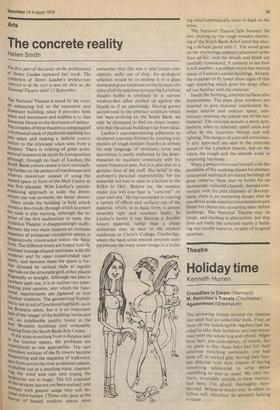Arts
The concrete reality
Helen Smith
The first part of this essay on the architecture of Denys Lasdun appeared last week. The exhibition of Denys Lasdun's architecture referred to in the text is now on view at the National Theatre until l I September.
The National Theatre is saved by the river, an enhancing foil to the expansive and dominant building, since it provides both space and movement and enables it to face Somerset House to the detriment of neither. The complex of three theatres is composed of a rhythmical stack of platforms reaching out into space and making a definite contribution to the cityscape when seen from a distance. There is nothing of great architectural interest to be spoilt by juxtaposition although, through no fault of Lasdun, the South Bank culture centre is now encroaching further on the pattern of warehouses and Wharves downriver instead of using the Wasted space in front of the Shell Centre as Was first planned. With Lasdun's uncomPromising approach to scale, the downstream site was probably the better choice. Once inside the building (a bold attack reveals a few chinks through which to enter) the scale is also exciting, although the interior of the first auditorium to open, the I-Yttelton Theatre, is disappointingly stuffy. Between the two main theatres an intricate e•quence of polygonal circulation spaces is linaginatively constructed within the basic form. The different levels are linked both by enclosed lozenge-shaped staircases with Slit Windows and by open round-ended stair Shafts, and between them the space is further directed by vertical slabs at regular Intervals on the structural grid, either placed diagonally or straight. Although the plan is h, °where spelt out, it is in outline two interloc. king pure squares, into which the functional requirements are jigsawed in true classical tradition. The geometrical formalistli is not in aid of functional legibility, as in the Brutalist ethos, but it is an important Part of the 'image' of the building, inside and elkin, an indefinable quality found in the ue.st Brutalist buildings and noticeably missing from the South Bank Arts Centre. . If the scale is exciting from a distance and In the interior spaces, the problems are experienced as one approaches. The vast tun broken surfaces of the fly towers become shreatening and the sequence of walkways, _tieri from across the river as abstract planes, rYstallise out as a puzzling maze, channelling the wind and rain and urging the Poe_destrian not to linger. The full potential r the terraces has not yet been realised, and Perhaps with greater usage they will be', °Me more human. (Those who gasp at the horror of heated outdoor spaces must
remember that this was a mid-'sixties conception, sadly out of date. An ecological solution would be to enclose it in a glass dome and grow tomatoes on the terraces.) In spite of all the spacious terraces the Lyttelton theatre buffet is confined to a narrow window-box affair pushed up against the façade as if an appendage. Having grown accustomed to the abstract sculpture which has been evolving on the South Bank, we may be dismayed to find on closer inspection that the actual building is far from ideal.
Lasdun's uncompromising adherence to shuttered concrete (formed by pouring into moulds of rough wooden boards) as almost his Sole language of structure,. form and decoration is partly explained by his determination to maintain continuity with his recent historical past, but it is also due to a genuine love of the stuff. His belief in the architect's personal responsibility for his materials led him to state in a lecture to the RIBA in 1965, 'Believe me, the sweetest music you will ever hear is "concrete" on your own site.' He has succeeded in coaxing a variety of effects and surfaces out of the material, which, in its basic form, is almost invaribly ugly and weathers badly. In Lasdun's hands it can become a durable luxury material, rather than a cheap utilitarian one, as seen in the .student residences at Christ's College, Cambridge, where the hard white precast concrete slabs perpetuate the ivory tower image in a build
ing which emphatically turps its back on the town.
The National Theatre falls between the two, picking up the rough wooden shuttering of the South Bank Arts Centre but playing a de-luxe game with it. The wood grain on the shutterings appears calculated rather than ad hoc, and the details and finish are carefully considered. It remains to see how it will weather, a problem which has marred many of Lasdun's earlier buildings. Already the expanses of fly tower show signs of that ugly streaking which gives the dingy effect all too familiar with the material.
Inside the building, concrete surfaces also predominate. The plate glass windows are inserted to give minimal interference between interior and exterior space, consciously stressing the ethical use of the raw material. The concrete texture is more sympathetic when in relatively small areas and offset by the luxurious fittings and soft lighting. The dangers of a too self-consciously arty approach are seen in the concrete mural of the Lyttelton theatre, but on the whole the rough and the smooth work in surprising harmony.
When Lasdun concerned himself with the problems of the working classes his abstract conceptual approach produced buildings of great integrity. Now that he builds for an increasingly cultured clientele, deemed conversant with his past channels of development, there is an increasing danger that he can thrust aside material considerations and flatter his clients into accepting ideas before buildings. The National Theatre may be tough, and exciting in abstraction, but that does not make the concrete reality a building that people warm to, in spite of its good qualities.


























 Previous page
Previous page